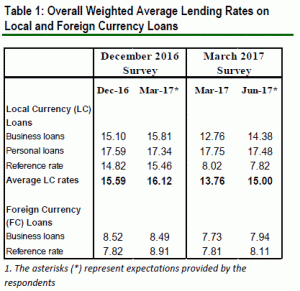BOJ Credit Condition Survey
According to the Bank of Jamaica (BOJ), Credit Condition Survey revealed heightened competition in the banking sector arising from the conversion of Jamaica National Building Society to a commercial bank on February 01, 2017. The effect of the conversion lowered the weighted average lending rate to 14.98% from 16.21% in December 2016 according to the report. The reduction reflected the competitiveness in rates as players aspired to maintain and possibly increase market share.
Credit Supply
The Credit Supply Index moderated to 103.8 for March 2017 from 104.6 in the previous quarter. The temperance was as a result of a slowdown in the rate of growth in credit made available to micro businesses, relative to the previous quarter. The BOJ also indicated that institutions’ willingness to provide credit is driven by improved macroeconomic conditions and a more competitive market. The availability of local currency credit to business and individuals remained robust; however, one institution indicated that tight liquidity was a challenge during the quarter. Also of note, the pace of expansion in foreign currency credit made available was similar to that reported in the previous quarter.
The portion of credit made available to business continued to increase, rising to 48.0% in March 2017 from 45.0% in the previous survey, while personal loans accounted for 52.0% from 55.0% in the previous quarter. Large businesses continued to account for the majority of credit allocated to business, despite moderating during the quarter. This moderation in lending to large business was due to a shift in lending towards Micro, Small and Medium enterprises. For the June 2017 quarter, lenders plan to augment the amount of credit made available to prospective borrowers for both business and personal purposes.
Credit Demand
Growth in credit demand was relatively flat during the review period. The index rose from 101.5 to 107.7 despite a reduction in the pace of growth in demand for both personal and business loans. However, lenders noted that this phenomenon is generally characteristic of March quarters, the period during which the GOJ tables its estimates of expenditure, and is more pronounced in the demand for business loans.
The BOJ indicated that the slowed growth in the demand for local currency business loans was as a result of a contraction in demand for credit from the Mining & Quarrying, Distribution, Manufacturing and Entertainment sectors. On the other hand, there was strong demand for foreign currency loans from the Construction, Tourism and Distribution sectors. Lenders also noted that the stability in the exchange rate during the review quarter made it feasible for businesses to borrow in foreign currency. For the June 2017 quarter, lenders indicated that they are anticipating an uptick in the growth in credit demand from both individuals and businesses.

